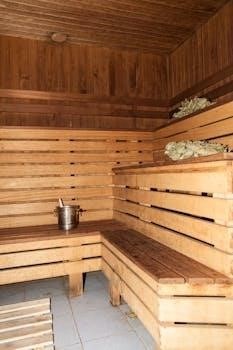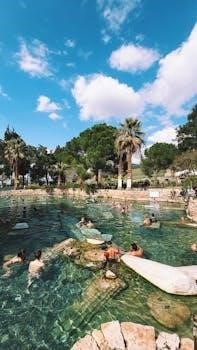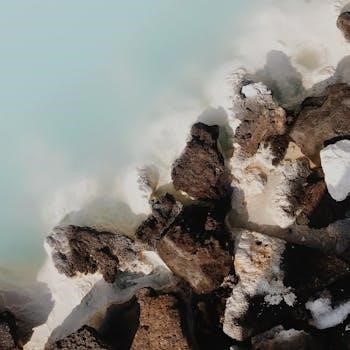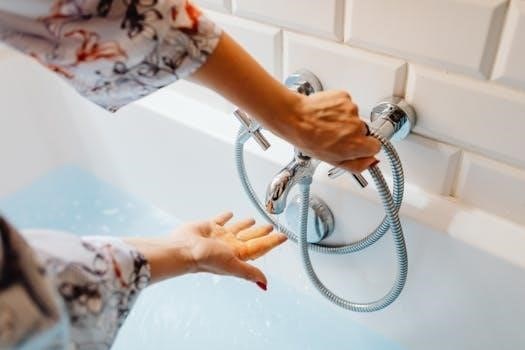
Is your Hot Spring spa not performing as expected? Don’t worry‚ many common issues have simple solutions. This guide provides troubleshooting steps for various problems‚ from heating issues to water quality concerns. Remember‚ if you’re uncomfortable‚ contact a qualified hot tub technician for assistance.
Common Hot Tub Problems
Several common hot tub issues can disrupt your relaxation. These include problems with heating‚ where the water doesn’t reach the desired temperature or fails to hold steady. Jets not working properly‚ either exhibiting weak pressure or failing to activate altogether‚ is another frequent concern. Noisy pumps‚ emitting growling or squealing sounds‚ can also detract from the spa experience.
Water chemistry imbalances‚ such as cloudy water or improper pH levels‚ are also common culprits. Error codes displayed on the control panel often indicate specific malfunctions within the system. Additionally‚ the GFCI breaker tripping frequently can signal electrical issues‚ such as faulty wiring or a malfunctioning component.
Leaks‚ whether from pipes‚ the heater‚ or the pump‚ can lead to water loss and potential damage. Furthermore‚ issues related to filter maintenance‚ such as clogged or dirty filters‚ can affect water quality and overall spa performance. Addressing these common problems promptly can help maintain your hot tub’s functionality and longevity.
Water Chemistry Imbalance
Maintaining proper water chemistry is crucial for a clean‚ safe‚ and enjoyable hot tub experience. One of the most common issues is cloudy water‚ often caused by low sanitizer levels. As sanitizers like chlorine or bromine work to clean the water‚ their levels deplete‚ especially with increased hot tub usage. Regularly testing the water with test strips is essential to monitor sanitizer levels and make necessary adjustments.
Imbalances in pH levels can also lead to various problems. Low pH (below 7.0) can corrode the heating element and cause the GFCI breaker to trip. High pH‚ on the other hand‚ can reduce the effectiveness of sanitizers and cause scaling. Maintaining the correct pH balance is vital for both equipment longevity and water clarity.
Other factors contributing to water chemistry issues include alkalinity levels and the presence of contaminants. Ensuring proper alkalinity helps stabilize pH levels‚ while regular shocking can eliminate organic contaminants. Addressing these imbalances promptly will keep your hot tub water sparkling clean and prevent potential damage to the spa components.
Heating Issues
A hot tub that won’t heat properly can quickly diminish the relaxation experience. Several factors can contribute to heating problems‚ starting with thermostat malfunctions. If the hot tub isn’t heating up or the temperature isn’t holding steady‚ a faulty thermostat might be the cause. Check the control panel for the heater light indicator or thermometer icon. If the light is on or the icon is moving‚ the hot tub should be actively heating.
Low water flow can also hinder the heating process. Insufficient water circulating through the heater can prevent it from efficiently warming the water. Blocked filters or a malfunctioning pump can restrict water flow‚ leading to heating issues. Regular filter maintenance is crucial to ensure proper flow.
Another potential culprit is a faulty heating element. Over time‚ the heating element can corrode‚ particularly due to low pH levels. This corrosion can cause the element to fail‚ preventing the hot tub from heating. Additionally‚ a high limit switch problem can interrupt the heating process. If the high limit switch trips‚ it can shut off the heater to prevent overheating‚ requiring a reset.
Noisy Pump Troubleshooting
A noisy hot tub pump can disrupt the tranquility of your spa experience. Identifying the type of noise is the first step in troubleshooting. A growling or grumbling sound often indicates a problem with the pump’s motor bearings. Over time‚ these bearings can wear out‚ causing the motor to vibrate and produce a rumbling noise.
A high-pitched squeal‚ on the other hand‚ might suggest a problem with the pump’s impeller or seals. The impeller is responsible for circulating water‚ and if it’s damaged or obstructed‚ it can create a squealing sound. Similarly‚ worn or damaged seals can allow air to enter the pump‚ leading to cavitation and noise.
Another potential cause of pump noise is debris lodged within the pump housing. Leaves‚ dirt‚ or other foreign objects can obstruct the impeller‚ causing the pump to work harder and generate noise. Inspecting and cleaning the pump housing can often resolve this issue. Additionally‚ ensure that the pump is properly mounted and secured. Loose mounting bolts can allow the pump to vibrate‚ amplifying the noise.

Jets Not Working
If your hot tub jets aren’t working‚ it can significantly impact your spa experience. Several factors can contribute to this issue‚ and troubleshooting involves systematically checking potential causes. First‚ ensure that the jets are fully open. Many hot tub jets are adjustable and can be turned on or off individually. Verify that each jet is in the “on” position.
Next‚ check the water level in your hot tub. If the water level is too low‚ the pump may not be able to draw enough water to power the jets effectively. Add water to the spa until it reaches the recommended level. Also‚ inspect the filter for clogs or debris. A dirty filter can restrict water flow‚ reducing the pressure to the jets. Clean or replace the filter as needed.
Another common cause of jet problems is airlocks in the plumbing lines. Air can become trapped in the pipes‚ preventing water from flowing freely. To release airlocks‚ try turning the pump on and off several times. You can also try opening and closing the jets to help dislodge any trapped air. If the problem persists‚ you may need to consult a hot tub professional to bleed the lines properly.
Error Codes on Control Panel
When your hot tub displays an error code‚ it’s communicating a specific problem that needs attention. The control panel is essentially signaling that something is not functioning correctly within the spa’s system. Instead of panicking‚ view the error code as a helpful starting point for diagnosing the issue. Consulting your hot tub’s manual is crucial‚ as it will contain a list of error codes specific to your model and their corresponding meanings.

Some common error codes relate to water temperature‚ indicating either overheating or a failure to heat. Others might point to issues with the water flow‚ sensor malfunctions‚ or problems with the heating element. Once you’ve identified the meaning of the error code‚ you can begin troubleshooting. For instance‚ if the code indicates a water flow problem‚ check the filter for clogs and ensure that the water level is adequate.
In some cases‚ simply resetting the hot tub by turning off the power for a few minutes and then turning it back on can clear the error code. However‚ if the code reappears‚ it signifies a persistent problem that requires further investigation. Keep a list of common error codes near your spa for quick reference. If you’re unable to resolve the issue yourself‚ contacting a qualified hot tub technician is recommended to avoid further damage.
GFCI Breaker Tripping
A Ground Fault Circuit Interrupter (GFCI) breaker is a safety device designed to protect you from electrical shock. When it trips‚ it indicates that there’s an imbalance in the electrical current‚ suggesting a potential ground fault. If your hot tub’s GFCI breaker is tripping‚ it’s crucial to address the issue promptly and safely. Do not repeatedly reset the breaker without investigating the cause‚ as this could be dangerous.
One common reason for a GFCI breaker tripping is moisture intrusion. Check for any leaks around the hot tub’s components‚ such as the pump‚ heater‚ or control panel. Even a small amount of water in the wrong place can cause a short circuit. Another potential cause is a faulty component‚ such as a failing heating element or a damaged pump motor. Low pH for an extended period can damage the heating element and cause the GFCI breaker to trip.
To troubleshoot‚ start by inspecting the hot tub’s wiring for any signs of damage or corrosion. If you’re comfortable working with electricity‚ you can use a multimeter to test the continuity of the various components. However‚ if you’re not experienced‚ it’s best to call a qualified electrician or hot tub technician. They can diagnose the problem accurately and perform the necessary repairs to ensure your safety and the proper functioning of your hot tub.
Troubleshooting Inflatable Hot Tubs
Inflatable hot tubs offer a convenient and affordable way to enjoy the spa experience. However‚ like any hot tub‚ they can encounter problems. Due to their construction‚ inflatable hot tubs have some unique troubleshooting considerations. Identifying and addressing these issues promptly can extend the life of your inflatable spa and ensure continued enjoyment.
One common problem is air leakage. Check the seams and valves for any signs of punctures or damage. A soapy water solution can help pinpoint leaks. Apply the solution to suspect areas; bubbles will form where air is escaping. Patch kits are typically included with inflatable hot tubs for minor repairs.
Another frequent issue is heating problems. Ensure the filter is clean‚ as a clogged filter can restrict water flow and affect heating efficiency. Check the control panel for error codes and consult the manufacturer’s instructions for troubleshooting steps. Inadequate water chemistry can also impact heating performance. Maintain proper sanitizer levels and pH balance. Additionally‚ inspect the power cord and GFCI plug for any damage. If the hot tub is not heating‚ ensure the heater light indicator is on and the thermometer icon is moving. Wait a reasonable amount of time to see if the water temperature is changing.
Hot Tub Filter Maintenance
Maintaining a clean hot tub filter is crucial for optimal spa performance and water quality. A dirty filter restricts water flow‚ reducing the effectiveness of the jets and straining the pump. Regular cleaning and replacement of the filter are essential for clear‚ clean‚ and healthy water.
The frequency of filter cleaning depends on usage‚ but a general guideline is to clean the filter every two to four weeks. To clean the filter‚ first‚ remove it from the filter housing according to the manufacturer’s instructions. Rinse the filter thoroughly with a garden hose‚ using a filter cleaning nozzle to remove debris trapped between the pleats. For a more thorough cleaning‚ soak the filter in a filter cleaning solution specifically designed for hot tubs. Follow the instructions on the cleaning solution for dilution and soaking time. After soaking‚ rinse the filter again with the garden hose to remove any remaining cleaning solution.
In addition to regular cleaning‚ the filter should be replaced every 12 to 18 months‚ depending on usage and water quality. Over time‚ the filter media can become worn and less effective at removing contaminants. Replacing the filter ensures optimal filtration and extends the life of your hot tub equipment.

Hot Tub Cover Cleaning
The hot tub cover is a vital component of your spa‚ protecting it from the elements‚ retaining heat‚ and preventing debris from entering the water. Regular cleaning and maintenance of the cover are essential to prolong its life and maintain its effectiveness. Neglecting the cover can lead to discoloration‚ cracking‚ and eventual damage‚ requiring costly replacement.
To clean your hot tub cover‚ start by removing any loose debris‚ such as leaves‚ twigs‚ or dirt. Use a soft brush or cloth to gently sweep the surface. Next‚ prepare a cleaning solution using mild soap and water. Avoid harsh chemicals or abrasive cleaners‚ as these can damage the cover’s vinyl or synthetic material. Apply the cleaning solution to the cover and scrub gently with a soft brush or sponge. Pay particular attention to areas with stubborn stains or mildew growth.

Once you have cleaned the entire cover‚ rinse it thoroughly with a garden hose. Ensure that all soap residue is removed‚ as this can attract dirt and promote mildew growth. After rinsing‚ allow the cover to air dry completely before replacing it on the hot tub. To further protect the cover‚ consider applying a vinyl protectant specifically designed for hot tub covers. This will help to prevent UV damage‚ cracking‚ and fading;
Winterizing Hot Tubs
When cold weather approaches‚ properly winterizing your hot tub is crucial if you plan to shut it down for the season. This process prevents freeze damage to pipes‚ pumps‚ and other components‚ saving you costly repairs. Neglecting winterization can lead to cracked pipes‚ damaged equipment‚ and a significant headache when you’re ready to use your spa again.
First‚ disconnect the power to your hot tub at the breaker. Then‚ drain all the water from the spa‚ including the plumbing lines. Use a wet/dry vacuum to remove any remaining water from the jets‚ pump housings‚ and filter compartment. Next‚ remove the filter and clean it thoroughly before storing it in a dry place.
To protect the pipes from freezing‚ use an RV antifreeze specifically designed for plumbing systems. Pour the antifreeze into the filter housing‚ pump unions‚ and any other accessible plumbing connections. This will displace any remaining water and prevent it from freezing and expanding. Finally‚ cover the hot tub with a secure‚ waterproof cover to protect it from snow‚ ice‚ and debris. Consider using a cover support to prevent snow from accumulating and damaging the cover. By following these steps‚ you can ensure that your hot tub survives the winter unscathed and is ready for use when warmer weather returns.